Pet insurance can help reduce the financial burden of unexpected veterinary bills, ensuring that your pet gets the care they need without you having to worry about the cost. However, not all pet insurance policies are the same. Understanding the different types of pet insurance and their coverage options is essential in selecting the right policy for your furry companion. The three main types of pet insurance are comprehensive (accident and illness), accident-only, and wellness/preventive care coverage.
1. Comprehensive (Accident and Illness) Coverage
Comprehensive pet insurance is the most inclusive type of coverage, designed to cover both accidents and illnesses. It’s often considered the most valuable type of policy because it provides protection for a broad range of health issues your pet may face throughout its life. This type of insurance covers everything from emergency accidents to chronic illnesses and even breed-specific conditions.
What It Covers:
- Accidents: Injuries like broken bones, bite wounds, or swallowed objects are included.
- Illnesses: Coverage for common illnesses, such as ear infections, skin conditions, and serious diseases like cancer, diabetes, or kidney disease.
- Chronic Conditions: Long-term conditions like arthritis, diabetes, and allergies can be covered as long as they are diagnosed after the policy begins. Early coverage of chronic conditions is important since many policies will not cover these conditions if they are deemed “pre-existing.”
- Breed-Specific Conditions: Some pets are more prone to specific hereditary conditions. For example, large dogs might be susceptible to hip dysplasia, and smaller breeds may have heart problems. Depending on the plan, some of these conditions are covered.
- Diagnostic Tests and Treatments: Costs of X-rays, blood tests, CT scans, MRIs, and other diagnostic procedures are often reimbursed under this coverage.
- Prescription Medications: Most plans cover medications prescribed for illnesses and treatments.
- Surgical Procedures and Hospitalization: Coverage includes the costs associated with surgery, anesthesia, and post-surgical care.
What It Doesn’t Cover:
- Pre-existing Conditions: Any condition your pet was diagnosed with before the start of the policy.
- Cosmetic Procedures: Elective or cosmetic procedures like ear cropping, tail docking, or declawing are excluded.
- Breeding and Pregnancy: Costs related to breeding, pregnancy, or birth are typically not covered.
- Routine Care: Unless you have added a wellness plan, routine check-ups, vaccinations, and preventive care aren’t included in comprehensive policies.
Why Choose Comprehensive Coverage:
Comprehensive coverage is ideal if you want peace of mind knowing your pet is protected against a wide range of illnesses and accidents. Although it is the most expensive option, the breadth of coverage means it can save you significant amounts of money if your pet develops a serious condition or faces a medical emergency. For instance, treatments for conditions like cancer can exceed $6,000, and without insurance, these costs can be overwhelming.
2. Accident-Only Coverage

Accident-only pet insurance is a more affordable option than comprehensive coverage and is designed to cover expenses related to accidents or injuries only. This type of insurance is suitable for pets that are otherwise healthy but may be prone to accidents or injuries, or for owners who want some financial protection but are on a budget.
What It Covers:
- Accidental Injuries: This includes injuries from car accidents, falls, or physical altercations with other animals.
- Emergency Treatment: Covers emergency veterinary visits due to injuries like broken bones, cuts, or foreign object ingestion.
- Surgery for Accidents: If surgery is needed due to an accident, this plan covers the associated costs.
- Poisoning or Toxin Exposure: If your pet ingests something toxic, the plan will typically cover the treatment and medications required.
What It Doesn’t Cover:
- Illnesses: Any health issue related to illness, including infections, cancer, or chronic conditions, is not covered.
- Pre-existing Conditions: Conditions diagnosed before the policy takes effect.
- Routine and Preventive Care: Wellness check-ups, vaccinations, and preventive treatments are excluded.
Why Choose Accident-Only Coverage:
Accident-only coverage is perfect for those who want to protect against the cost of unexpected injuries but are not as concerned about illnesses. This type of insurance is particularly useful for pets that are young, healthy, and active, as they might be more likely to injure themselves while playing or exploring. It’s also an option for older pets that may not qualify for comprehensive coverage due to age or existing medical conditions. Accident-only plans are significantly cheaper than comprehensive plans, making them an attractive choice for pet owners on a budget.
3. Wellness and Preventive Care Coverage

Wellness and preventive care coverage is not technically insurance but a supplemental plan designed to help pet owners cover routine and preventive care costs. These plans are usually offered as an add-on to a comprehensive or accident-only policy. While wellness coverage won’t protect you from the costs of unexpected illnesses or injuries, it can still help you manage the expense of keeping your pet healthy throughout the year.
What It Covers:
- Routine Exams: Annual or semi-annual wellness check-ups to monitor your pet’s overall health.
- Vaccinations and Preventive Treatments: Coverage for core vaccinations and treatments to prevent common health issues like fleas, ticks, and heartworm.
- Dental Cleanings: Some wellness plans offer coverage for routine dental care, such as cleanings.
- Spaying/Neutering: In some cases, higher-tier wellness plans will cover the cost of spaying or neutering.
- Microchipping: The plan may include coverage for microchipping to ensure your pet can be easily identified if lost.
- Routine Lab Work: Blood work, fecal tests, and urinalysis for preventive purposes.
What It Doesn’t Cover:
- Accidents or Illnesses: Wellness plans do not cover treatment for unexpected injuries or illnesses.
- Advanced Treatments: Complex procedures, emergency surgeries, or specialized care are not included.
- Pre-existing Conditions: As with other types of insurance, pre-existing conditions are excluded.
Why Choose Wellness Coverage:
Wellness and preventive care coverage is beneficial for pet owners who want to spread the cost of routine care over the year, making it more manageable. It encourages regular check-ups and preventive treatments, which can help catch health problems early. However, since it only covers routine care, it should be paired with accident or comprehensive coverage for full protection.
Other Coverage Options
In addition to the three primary types of pet insurance, there are specialized add-ons or riders that you can opt for, depending on your pet’s unique needs. These include:
- End-of-Life Care: Some plans provide coverage for euthanasia or cremation.
- Prescription Food: Coverage for prescribed food as part of a medical treatment.
- Behavioral Health: Coverage for treatments addressing behavioral problems like excessive chewing or anxiety.
Key Considerations When Choosing Pet Insurance
When selecting the right pet insurance policy, consider the following factors:
- Age of Your Pet: Younger pets can benefit most from comprehensive plans since they’re less likely to have pre-existing conditions. Older pets might qualify only for accident-only plans due to age-related exclusions.
- Breed-Specific Risks: Some breeds are prone to specific health issues. If your pet is of a breed with known risks, a comprehensive plan with coverage for hereditary conditions might be necessary.
- Budget: Comprehensive plans are more expensive but provide broader coverage, while accident-only plans are more affordable but limited in scope.
- Deductibles and Reimbursement: Check the deductibles and reimbursement percentages. Higher deductibles may lower monthly premiums, but you’ll need to pay more out-of-pocket when making a claim.
How Much Does Pet Insurance Cost?
Pet insurance premiums vary based on several factors, including your pet’s age, breed, and where you live.
On average, comprehensive coverage costs around $53 per month for dogs and $32 for cats. Accident-only plans are normally more affordable, with monthly premiums averaging around $17 for dogs and $10 for cats. Wellness care add-ons generally cost between $20 and $25 per month.
Final Thoughts
Pet insurance provides valuable financial protection against unexpected veterinary expenses, helping you manage the costs of accidents, illnesses, and routine care. Comprehensive insurance offers the broadest protection but comes at a higher cost. Accident-only coverage is a more affordable alternative for pets prone to injury. Wellness plans can supplement these policies by covering routine care. When choosing a policy, consider your pet’s specific needs, your financial situation, and the level of coverage that best suits your goals. With the right pet insurance plan, you can ensure that your beloved pet receives the care they deserve throughout their life.
So that was all about this article. If you have any further questions feel free to comment down below. We are always here to help you!




